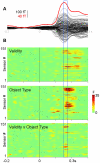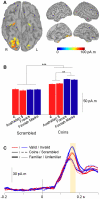Fast and automatic activation of an abstract representation of money in the human ventral visual pathway
- PMID: 22140556
- PMCID: PMC3227657
- DOI: 10.1371/journal.pone.0028229
Fast and automatic activation of an abstract representation of money in the human ventral visual pathway
Abstract
Money, when used as an incentive, activates the same neural circuits as rewards associated with physiological needs. However, unlike physiological rewards, monetary stimuli are cultural artifacts: how are monetary stimuli identified in the first place? How and when does the brain identify a valid coin, i.e. a disc of metal that is, by social agreement, endowed with monetary properties? We took advantage of the changes in the Euro area in 2002 to compare neural responses to valid coins (Euros, Australian Dollars) with neural responses to invalid coins that have lost all monetary properties (French Francs, Finnish Marks). We show in magneto-encephalographic recordings, that the ventral visual pathway automatically distinguishes between valid and invalid coins, within only ∼150 ms. This automatic categorization operates as well on coins subjects were familiar with as on unfamiliar coins. No difference between neural responses to scrambled controls could be detected. These results could suggest the existence of a generic, all-purpose neural representation of money that is independent of experience. This finding is reminiscent of a central assumption in economics, money fungibility, or the fact that a unit of money is substitutable to another. From a neural point of view, our findings may indicate that the ventral visual pathway, a system previously thought to analyze visual features such as shape or color and to be influenced by daily experience, could also able to use conceptual attributes such as monetary validity to categorize familiar as well as unfamiliar visual objects. The symbolic abilities of the posterior fusiform region suggested here could constitute an efficient neural substrate to deal with culturally defined symbols, independently of experience, which probably fostered money's cultural emergence and success.
Conflict of interest statement
Figures



Similar articles
-
Early influence of prior experience on face perception.Neuroimage. 2011 Jan 15;54(2):1415-26. doi: 10.1016/j.neuroimage.2010.08.081. Epub 2010 Sep 9. Neuroimage. 2011. PMID: 20832479
-
The Ventral Visual Pathway Represents Animal Appearance over Animacy, Unlike Human Behavior and Deep Neural Networks.J Neurosci. 2019 Aug 14;39(33):6513-6525. doi: 10.1523/JNEUROSCI.1714-18.2019. Epub 2019 Jun 13. J Neurosci. 2019. PMID: 31196934 Free PMC article.
-
Neural processing of food and monetary rewards is modulated by metabolic state.Brain Imaging Behav. 2018 Oct;12(5):1379-1392. doi: 10.1007/s11682-017-9811-y. Brain Imaging Behav. 2018. PMID: 29243121
-
The neural basis of object perception.Curr Opin Neurobiol. 2003 Apr;13(2):159-66. doi: 10.1016/s0959-4388(03)00040-0. Curr Opin Neurobiol. 2003. PMID: 12744968 Review.
-
Visual saliency and spike timing in the ventral visual pathway.J Physiol Paris. 2003 Mar-May;97(2-3):365-77. doi: 10.1016/j.jphysparis.2003.09.010. J Physiol Paris. 2003. PMID: 14766152 Review.
Cited by
-
Attentional modulation of reward processing in the human brain.Hum Brain Mapp. 2014 Jul;35(7):3036-51. doi: 10.1002/hbm.22383. Epub 2013 Dec 5. Hum Brain Mapp. 2014. PMID: 24307490 Free PMC article.
-
The Effects of the Activation of Money and Credit Card vs. that of Activation of Spirituality - Which One Prompts Pro-Social Behaviours?Curr Psychol. 2016;35(3):344-353. doi: 10.1007/s12144-014-9299-1. Epub 2014 Dec 24. Curr Psychol. 2016. PMID: 27729764 Free PMC article.
-
Value is in the eye of the beholder: early visual cortex codes monetary value of objects during a diverted attention task.J Cogn Neurosci. 2015 May;27(5):893-901. doi: 10.1162/jocn_a_00760. Epub 2014 Nov 12. J Cogn Neurosci. 2015. PMID: 25390198 Free PMC article.
-
Reward speeds up and increases consistency of visual selective attention: a lifespan comparison.Cogn Affect Behav Neurosci. 2014 Jun;14(2):659-71. doi: 10.3758/s13415-014-0273-z. Cogn Affect Behav Neurosci. 2014. PMID: 24744244
References
-
- Thut G, Schultz W, Roelcke U, Nienhusmeier M, Missimer J, et al. Activation of the human brain by monetary reward. Neuroreport. 1997;8:1225–1228. - PubMed
-
- Knutson B, Westdorp A, Kaiser E, Hommer D. FMRI visualization of brain activity during a monetary incentive delay task. Neuroimage. 2000;12:20–27. - PubMed
-
- Breiter HC, Aharon I, Kahneman D, Dale A, Shizgal P. Functional imaging of neural responses to expectancy and experience of monetary gains and losses. Neuron. 2001;30:619–639. - PubMed
Publication types
MeSH terms
LinkOut - more resources
Full Text Sources

